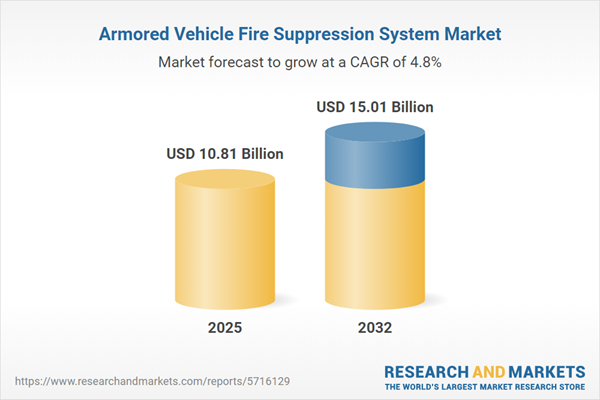Speak directly to the analyst to clarify any post sales queries you may have.
The armored vehicle fire suppression system market is evolving as defense and security organizations worldwide adopt advanced safety solutions to safeguard personnel and assets. Senior leaders increasingly seek intelligent and dependable systems that address modern operational risks and support strategic planning for asset protection and survivability.
Market Snapshot: Armored Vehicle Fire Suppression System Market
In 2024, the armored vehicle fire suppression system market reached a value of USD 10.30 billion, with forecasts anticipating growth to USD 10.81 billion by 2025 and a compound annual growth rate of 4.81%. Expansion is primarily fueled by defense modernization initiatives, enhanced safety regulations, and growing preference for modular and interoperable systems. Decision-makers across both the public and private sectors are optimizing procurement approaches to address rapidly changing threat profiles. Technology advancements focus on faster detection, enhanced responsiveness, and system integration, confirming the essential role of fire suppression in global defense and security strategies.
Scope & Segmentation
- Platform Types: Fire suppression solutions are customized for diverse vehicle categories, including tracked reconnaissance vehicles, infantry fighting vehicles, main battle tanks, and wheeled personnel carriers, supporting fleet-wide adaptability and task readiness.
- Suppression Agents: Several agent types are in use, such as rapid-release aerosols, micronized chemical agents, liquefied foam, water mist, and specialized suppression gases like CO2, FM200, and Novec 1230. These options are chosen for their efficiency, rapid action, and streamlined upkeep.
- System Operation Modes: Systems can be automatic, manual, or semi-automatic, allowing organizations to align response mechanisms with specific risk levels and operational requirements.
- End Users: Military, homeland security, and law enforcement agencies deploy robust fire suppression systems designed to withstand complex, demanding environments while ensuring personnel safety and continuity of mission.
- Applications: Integrated systems protect essential sections of vehicles, such as crew and engine compartments. Portable firefighting units further supplement safety in regions where onboard protection may be limited or access is restricted.
- Regional Markets: Demand spans the Americas, Europe, Middle East, Africa, and Asia-Pacific. Country-specific regulations and procurement patterns—particularly in the United States, Germany, China, India, and Australia—influence certification requirements and supply chain strategies for suppliers and buyers.
- Key Technology Innovators: Market advancements are shaped by global companies, including Johnson Controls International plc, Carrier Global Corporation, Fike Corporation, SPX Corporation, Halma plc, Firetrace International LLC, Siemens AG, Robert Bosch GmbH, Honeywell International Inc., and Chubb Limited. Their initiatives advance detection capabilities, enhance supply chain reliability, and drive sustainability in deployment.
Key Takeaways for Decision-Makers
- Accelerated detection and suppression mechanisms are fundamental for mitigating vehicle damage and ensuring crew protection in increasingly complex operational scenarios.
- Deployment of intelligent sensors and integration with real-time analytics can increase situational awareness and support proactive planning for maintenance and readiness.
- Integrating suppression systems within onboard controls streamlines emergency protocols, helping harmonize operational and safety objectives under contemporary risk management standards.
- Modular architectures enable straightforward upgrades and customized solutions tailored to urban, off-road, or hybrid operations, allowing organizations to respond to evolving requirements.
- Collaboration among manufacturers, technology developers, and industry research organizations is promoting advances in system interoperability and the adoption of future-proof technologies.
- Remote diagnostic capabilities and predictive maintenance support efficient logistics planning and help maximize operational lifespan for fleets deployed across diverse geographies.
Tariff Impact on Market Resilience
Recent U.S. tariff adjustments related to fire suppression system components and agents are affecting procurement planning. There is a marked shift toward localized sourcing, which helps organizations strengthen supply chain stability while ensuring regulatory compliance. This strategic adjustment is vital for maintaining production timelines and reducing risk associated with critical materials, thus supporting reliable deployment in markets influenced by tariff changes.
Methodology & Data Sources
This analysis synthesizes primary data from government records, technical certifications, and deployment reports. Direct input from procurement executives and fire protection specialists, combined with independent market research, delivers reliable and actionable insight tailored to this segment.
Why This Report Matters
- Enables informed procurement and lifecycle planning for defense, security, and law enforcement fleets, strengthening resource allocation and operational safety.
- Highlights leading technology partners and key segment trends, supporting accelerated market access and efficient acquisition strategies across diverse regions.
- Details strategies for deployment, certification, and support adaptable to stakeholders in established and emerging markets, helping to align investments with operational priorities.
Conclusion
Ongoing modernization of armored vehicle fire suppression systems underpins resilient risk management and sustained operational capability. Focused investment in advanced technologies ensures protection of personnel and assets across varied and high-stakes mission environments.
Additional Product Information:
- Purchase of this report includes 1 year online access with quarterly updates.
- This report can be updated on request. Please contact our Customer Experience team using the Ask a Question widget on our website.
Table of Contents
3. Executive Summary
4. Market Overview
7. Cumulative Impact of Artificial Intelligence 2025
Companies Mentioned
The companies profiled in this Armored Vehicle Fire Suppression System market report include:- Johnson Controls International plc
- Carrier Global Corporation
- Fike Corporation
- SPX Corporation
- Halma plc
- Firetrace International, LLC
- Siemens AG
- Robert Bosch GmbH
- Honeywell International Inc.
- Chubb Limited
Table Information
| Report Attribute | Details |
|---|---|
| No. of Pages | 195 |
| Published | October 2025 |
| Forecast Period | 2025 - 2032 |
| Estimated Market Value ( USD | $ 10.81 Billion |
| Forecasted Market Value ( USD | $ 15.01 Billion |
| Compound Annual Growth Rate | 4.8% |
| Regions Covered | Global |
| No. of Companies Mentioned | 11 |









